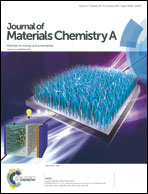Increased ion conduction in dual cation [sodium][tetraalkylammonium] poly[4-styrenesulfonyl(trifluoromethylsulfonyl)imide-co-ethylacrylate] ionomers†
Abstract
Solid-state polymer electrolytes, as an alternative to traditional liquid electrolytes, have been intensively investigated for energy conversion and storage devices. The transport rate of single ions is the key to their high performance. For application in emerging sodium batteries, we have developed three dual-cation polymeric ionomers, which contain bulky tetraalkylammonium ions in addition to the sodium ion. The sizes and relative contents of the ammonium ions vary relative to the sodium ion contents. Comparative studies of ion dynamics, thermal properties, phase behaviours and ionic conductivities were carried out, taking advantage of various spectroscopic and thermal chemistry methods. The ion conductivities of the ionomers are greatly enhanced by the introduction of bulky counterions, as a result of the additional free volume and decreased sodium ion association. Raman spectroscopy and thermal analysis as well as the solid-state nuclear magnetic resonance studies are used to probe the conductivity behaviour.
![Graphical abstract: Increased ion conduction in dual cation [sodium][tetraalkylammonium] poly[4-styrenesulfonyl(trifluoromethylsulfonyl)imide-co-ethylacrylate] ionomers](/en/Image/Get?imageInfo.ImageType=GA&imageInfo.ImageIdentifier.ManuscriptID=C5TA04407C&imageInfo.ImageIdentifier.Year=2015)

 Please wait while we load your content...
Please wait while we load your content...